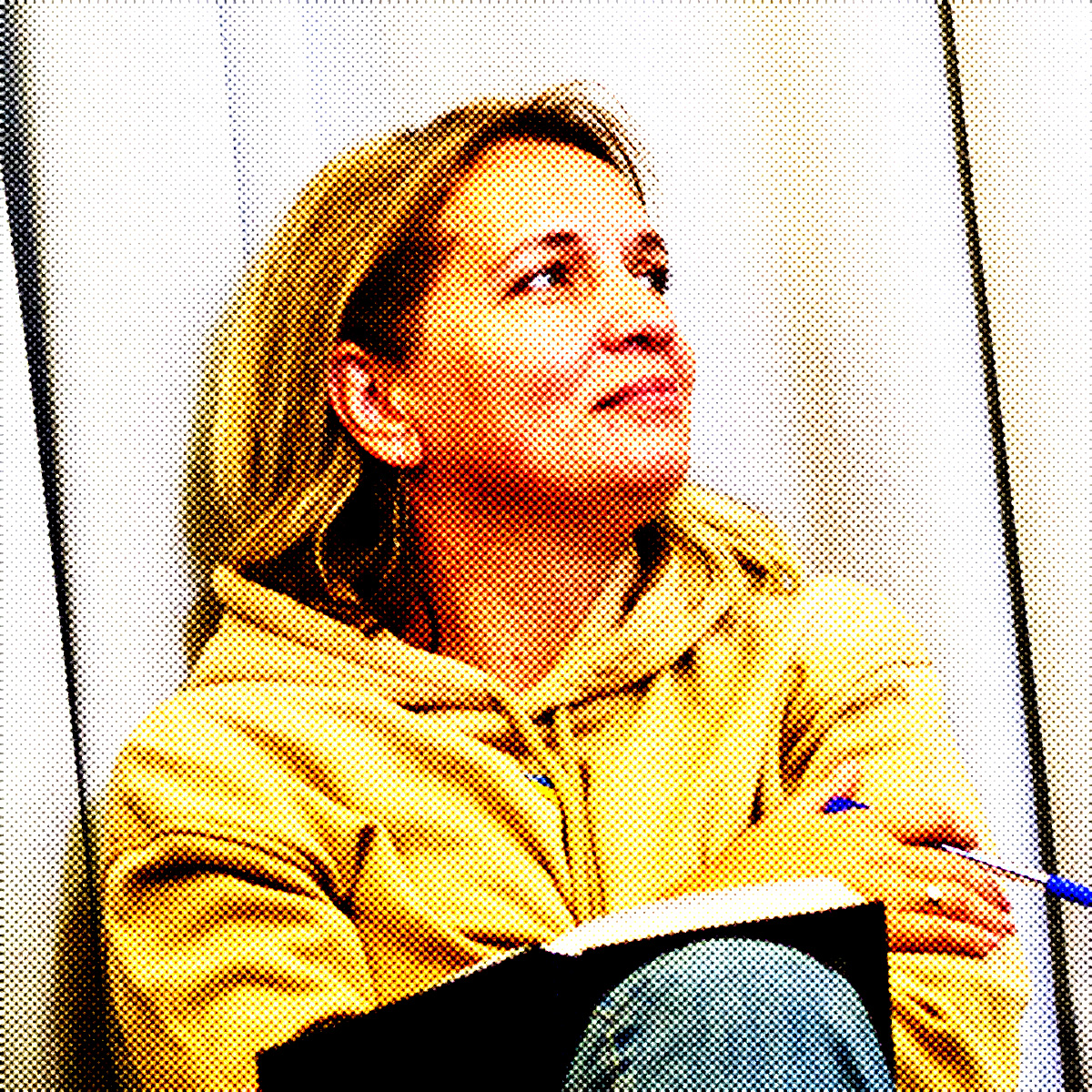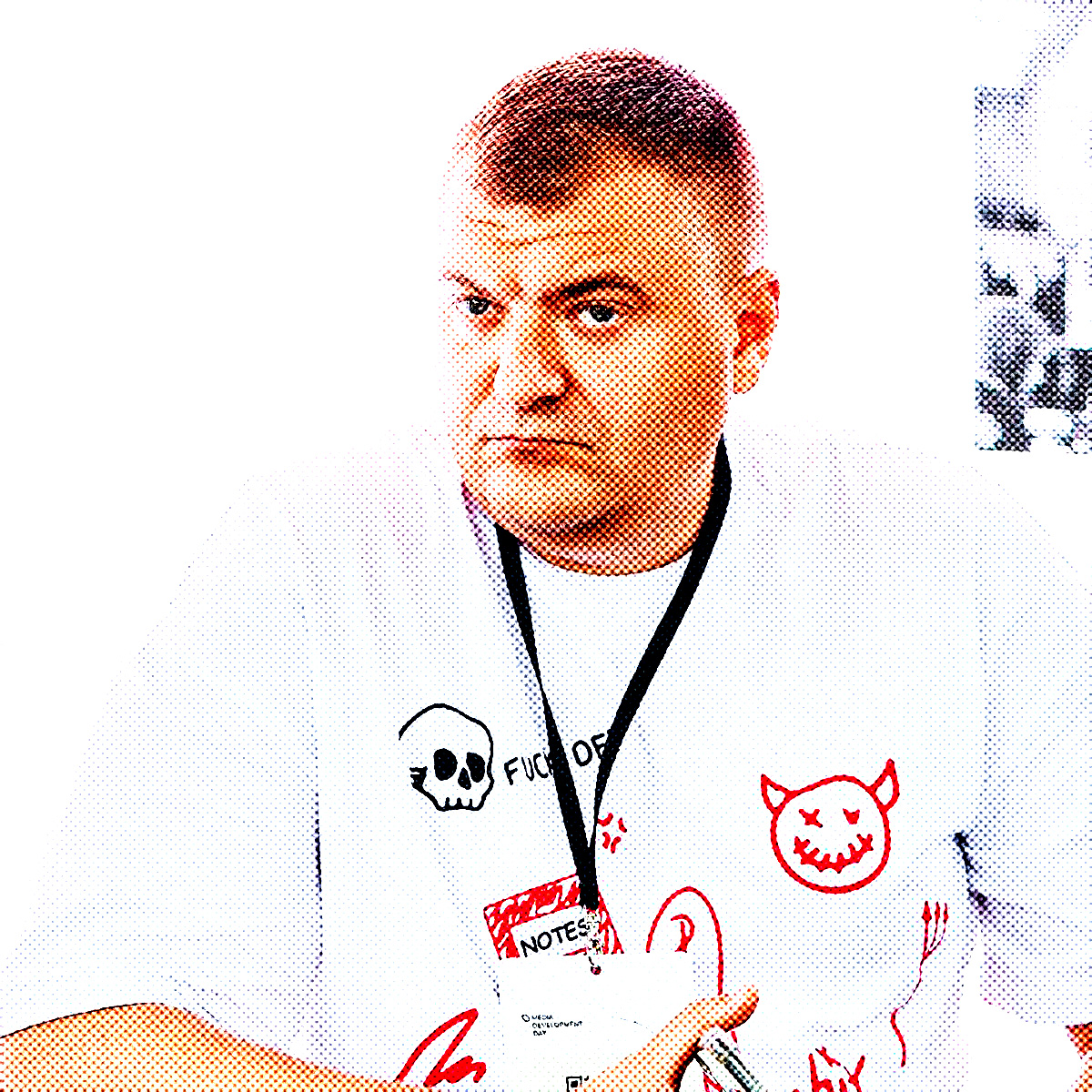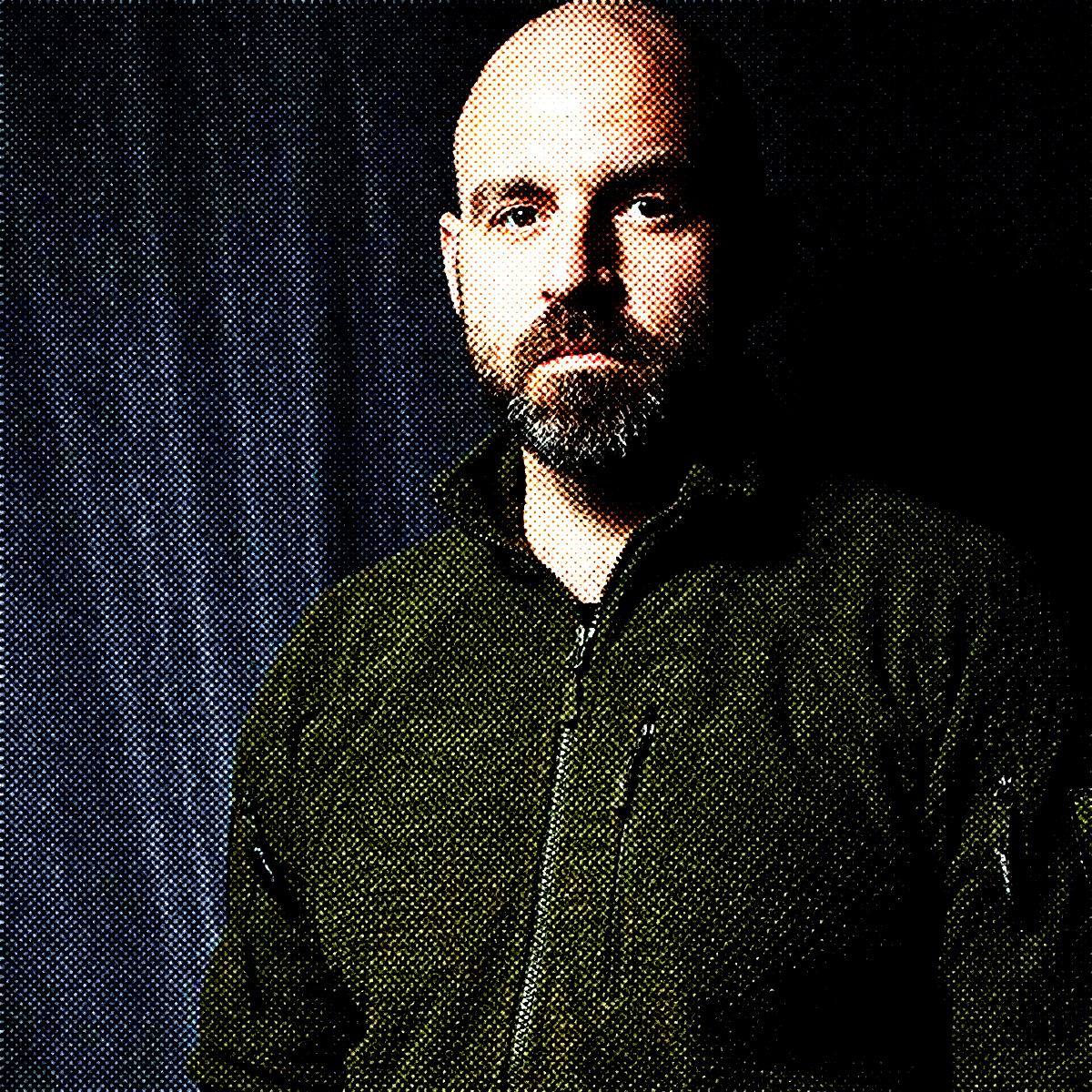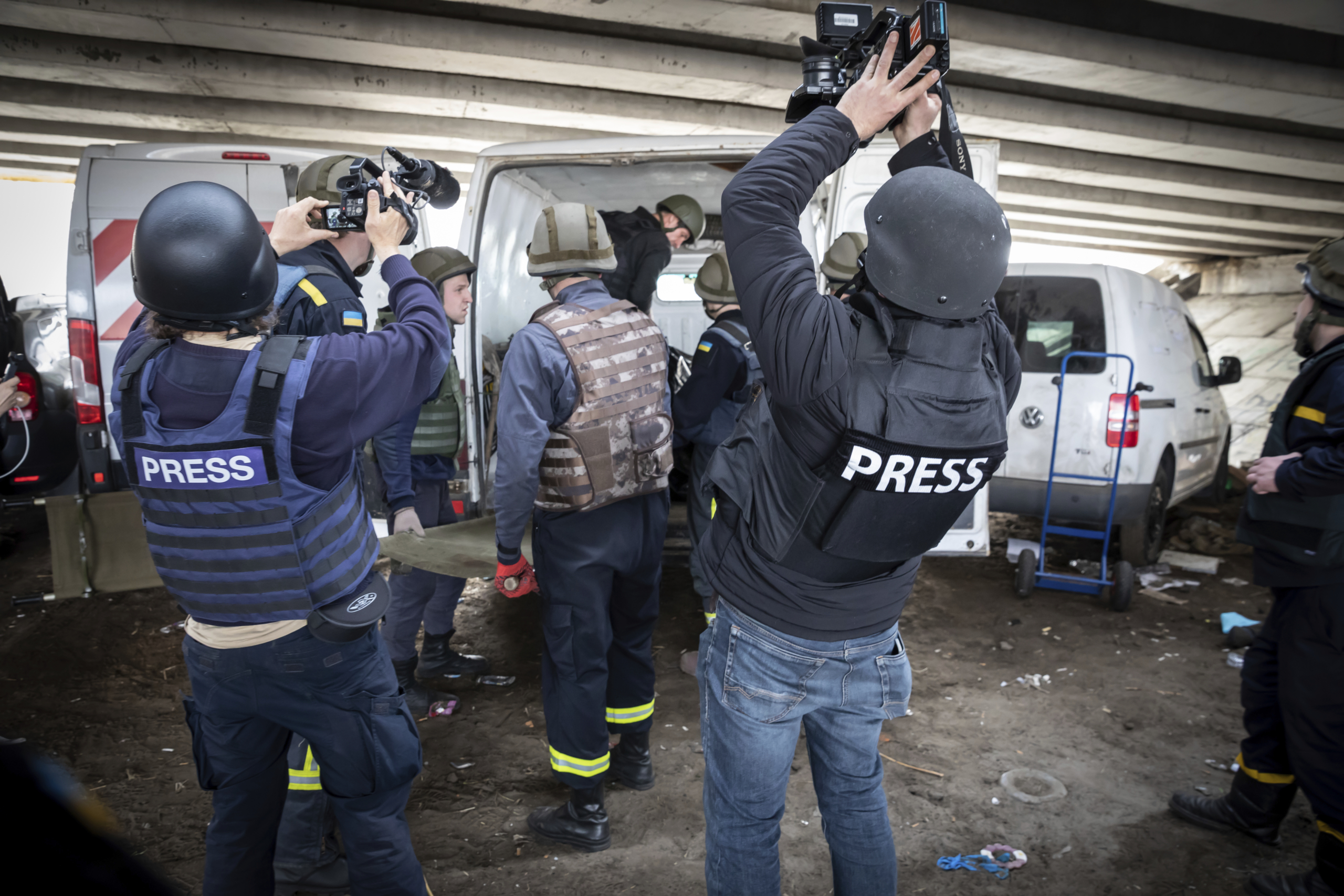Sign up for The Media Today, CJR’s daily newsletter.
On the facade of the small, ornate Stalinist building that houses the National Union of Journalists in central Kyiv, there is a brass plaque commemorating the life of Georgiy Gongadze, the founder of the country’s paper of record, Ukrainiska Pravda. He was murdered, his beheaded body discovered in a forest in 2000, less than a decade after the country gained independence from the Soviet Union. The person who ordered Gongadze’s murder is still at large; Gongadze’s death gave rise to a protest movement against Leonid Kuchma, the autocrat who served as Ukraine’s president until 2005. In the decade that followed, the country went through two revolutions and established a democracy; its independent press targeted government corruption. More journalists lost their lives during that period; the memorial lists some twenty other names below Gongadze’s. Yet since February 2022, when Russia’s deadly invasion began, the dangers facing Ukrainian reporters have been worse than ever before.
According to the Committee to Protect Journalists, at least fifteen journalists and media workers—most of them Ukrainians—have been killed since the start of the war; CPJ is investigating whether the deaths of two others were related to their reporting. In addition, there have been credible reports of journalists suffering torture; at least one is believed to be held illegally in a Russian prison. Some have quit their jobs for the army; others have engaged in perilous missions to rescue people being held in captivity or who have lost their homes. Recently, I talked to a few Ukrainian journalists about how the conflict has upended their lives.

In late February 2022, Anna Murlykina, who runs 0629—a news site named for Mariupol’s dial code—had to leave town, her terminally ill mother in tow. In the following days and weeks, Russian forces surrounded Mariupol and almost destroyed the city; within months, according to the United Nations Commission on Human Rights, 90 percent of Mariupol’s residential buildings had been flattened or damaged by carpet-bombings. For the past eighteen months, Murlykina has been talking to survivors. “It’s hard to do interviews. It’s hard to communicate,” she said. “I sort of wish I could quit my job right now. It would be psychologically easier to find something else not related to Mariupol.”
Murlykina, who is forty-nine, grew up in Mariupol. She had never loved the city, finding it “gray and ugly.” But an earlier Russian attempt to seize it, in 2014, changed her outlook, she said: she came close to losing her home, and realized how much it meant to her. This time around, the extent of the damage was far greater. “The people weren’t just killed by bombs,” she told me. “They died from starvation, lack of medical care. Heart attacks, strokes, kidney diseases, and so on.” Murlykina said that most of the survivors she’s interviewed suffer from post-traumatic stress disorder.
A former advertising manager at 0629 now writes obituaries of residents who died during the siege. (As Murlykina pointed out, the site no longer has advertisers; those who used to place ads have, for the most part, fled or died.) The site’s “Memorial” section now has more than nine hundred obits—a startling figure, yet nowhere near matching the number of people estimated to have died. Murlykina’s count is far higher than the government’s: “Twenty-two thousand is the most recent officially recorded figure,” she said. That represents the number of bodies that could be seen on the streets. “If you count the number of high-rise buildings blown up, that figure becomes a hundred thousand.”
Murlykina is distraught over what the Russians have done to Mariupol—along with dozens of other settlements in southern and eastern Ukraine—and she is outraged, too, at the Ukrainian government, and others in the West, for what she sees as a collective failure to protect her people. As the bombing started, she recalled, Ukrainian authorities were too busy “calming people down” to advise on an escape plan. “No one said, ‘Prepare to evacuate, be ready.’ So the first evacuation trains, which departed the city, left empty. No one believed there would be a siege. People were a hundred percent convinced Mariupol was a fortress.” Unlike most in Mariupol, however, the staff of 0629 had been listening more to the warnings of American intelligence than to the assurances offered by local authorities; they managed to get out in time. A few chose to stay; some joined the army. A member of the IT staff was killed in the shelling.
Before the invasion, Mariupol had a population of about 432,000. Today, Murlykina told me, only about a hundred thousand locals remain, along with seventy thousand settlers from various parts of Russia and central Asia. People who had come to Mariupol for work have mostly fled; those still around are largely pensioners, Murlykina said, or people who cannot imagine finding a job elsewhere. Any hope that the Ukrainian army will return seems scarcely imaginable: With a counteroffensive slowly crawling forward, troops remain some sixty miles away. The path forward runs through dense minefields and layers of defense. Murlykina’s own return to Mariupol feels like a distant dream. “The roads in the city are studded with mines,” she told me. “It’s really unsafe for biking. For a long time, the city will be dangerous for life, dangerous for children. So I think my decision will not be easy.”
For now, she is running 0629 from Kyiv. Her audience has dipped, she said, from some four million pageviews per month to about two million. “I realize that the longer the occupation lasts,” she said, “the less interesting we will become.”

In March, the International Criminal Court issued an arrest warrant for Vladimir Putin and Maria Lvova-Belova, Russia’s children’s commissioner, alleging they were responsible for the illegal transfer of Ukrainian children from occupied areas to Russia. For Yulia Khimeryk—a thirty-two-year-old Odesa-based journalist for Slidstvo Info, an investigative newsroom—the charges were hardly a surprise. Weeks earlier, she had helped two teenagers escape from imprisonment in the Russian-controlled city of Henichesk.
Nastya Mitrofanova, age eighteen, and Masha Senchuk, seventeen, had been students and roommates in the Ukrainian city of Kherson. Last fall, a tutor offered them a two-week holiday in Crimea; naively, they accepted. They left home on October 8, 2022. A month later, as Ukraine recaptured territory in the south, the girls were barred from returning home; instead, they were transported and placed in a Russian-run “boarding school,” along with thousands of other Ukrainian children who had been abducted. Khimeryk discovered them while searching for abducted children on Instagram.
Over several months, Khimeryk and the girls traded messages and videos. Mitrofanova and Senchuk told Khimeryk that they had been defying their captors: they refused to stand when the Russian anthem was played to their class and posted photos on their Instagram stories of blue and yellow balloons, shaped into a heart.
By February 2023, conditions had grown dire. The girls told Khimeryk that they feared being thrown in a torture pit—punishment for children who had displeased their captors. Soldiers would soon come to take them away, they said. Khimeryk informed her colleagues at Slidstvo. They contacted Ukrainian government agencies and NGOs, seeking help, but were told they would have to work out an extraction themselves. They devised a plan: The girls would say they needed to travel to a family wedding in Saint Petersburg. Khimeryk posed as their aunt; Mitrofanova and Senchuk wrote to her at every checkpoint along the way. “I did not sleep for four days,” Khimeryk said. “I had to keep on top of absolutely every step they took. So that if anything happened, I could try to help them. So I was elated when they wrote to me that they had passed through the final border checkpoint and had left Russia completely.”
Drawing from footage captured on the girls’ phones, Khimeryk compiled a film, Escape from Russians, which documents the dormitory in which they were forced to live. Khimeryk told me that she interviewed several other sources even younger than Mitrofanova and Senchuk, and the hell they endured was much the same. No other journalist has gotten as close as Khimeryk to Russia’s “boarding school” facilities. According to Ukrainian government figures, only several hundred of the children held in Russian custody have been evacuated.
Escape from Russians is Khimeryk’s first documentary for Slidstvo. Her top priority, she said, was the girls’ safe escape. “My colleagues call it activism,” she told me. “But I don’t consider it that. It seems to me that every journalist in my place would do everything to protect their sources.”
Nine months have passed since Mitrofanova and Senchuk’s return to Ukrainian-controlled territory. The Russian forces occupying some 20 percent of the country have been accused of genocide. “Our future depends on the investigations of these crimes,” Khimeryk told me. “Whether we will all be able to live at all.” At the time we spoke, she had just returned from a trip to the United States, where she aired the film before Congress. Details of the story, familiar to so many Ukrainian families, came as shocking news to politicians and their staffs. “Sometimes it seems to me that foreigners sympathize,” she said, “but they don’t understand the reality of what’s going on in the occupied territories.”

Serhiy Nikitenko is the editor of Most (“Bridge”), the top-read news site in Kherson, a provincial city in the south of Ukraine next to the Dnipro River. On one side, the regional capital is controlled by Ukrainians. A few miles away, on the “Left Bank,” Russian forces and collaborators oversee satellite towns. When they fire rounds over the water, there is not enough time for residents to seek shelter; the crossing over the Dnipro has long since been destroyed. More than five hundred civilians have died in Kherson; most residents have fled. Yet Nikitenko told me that for local journalism, much has remained the same as it ever was.
Nikitenko—who is forty, once an academic historian who began his writing career with a column in a local paper—founded Most eleven years ago, along with a colleague named Ekaterina Handziuk. While media rivals were on the payroll of Vladimir Saldo, who was the mayor at the time, Nikitenko and Handziuk wanted to fight corruption. “We realized that if we wanted free, democratic media, we would have to set up our own,” Nikitenko said. Saldo has since been appointed by the Russians as the region’s puppet governor.
For Most, pursuing investigative journalism proved dangerous from the start. In the summer of 2018, Nikitenko was beaten up. Local police told him that they never found the assailant. Later that year, Handziuk—who moved away from running the paper’s operations to become a muckraking regional politician—was doused with acid while leaving her apartment; that November, she died.
For years afterward, activists rallied, demanding justice for Handziuk’s killing; journalists researched the case. Finally, President Voldymyr Zelenskyy put pressure on state officials to legitimately investigate and prosecute the case. “We forced the system to work—both the police and the government,” Nikitenko said. “A huge effort by hundreds of people led to the result.” This summer, Vladislav Manger, a former assistant to Saldo, was convicted of ordering the attack. Manger was sentenced to ten years in prison.
Early into the war, the staff of Most almost all left Kherson; many returned last November, when the city was liberated by Ukrainian soldiers. “There was joy in the people and in us,” Nikitenko told me. “Immediately, we started working, finding people and recording their experiences. And even now, every time we transcribe their experiences under occupation, we cry while listening back to the recordings.” But the Ukrainian victory brought little relief to residents; the city has been shelled mercilessly since. In June, one of Ukraine’s largest dams was blown up, flooding the area. (It was located in a part of the region still under Moscow’s control; Ukraine has alleged that Russian soldiers destroyed it deliberately.) Most kept locals informed. Nikitenko compares his site to a punk rock band that has graduated from the garage to headlining festivals; since the Russian invasion began, he said, its readership has increased sixfold.
Recently, Most has received support from foreign foundations, enabling Nikitenko to bolster coverage. After the conflict ends, however, he wants to find a way for Ukrainians to fund independent media on their own, as part of community rebuilding led by locals who have remained in Kherson: “I hope that when the war ends with our victory, these people will be the basis of the civil society,” he said, “that these people will realize and remember how important it is to be involved.”

On February 24, 2022, Pavlo Kazarin was the host of three television shows on three networks, anchored a daily radio program, and wrote newspaper columns. He had worked in media nearly all of his adult life, including for Russian-opposition outlets in Moscow and as a reporter covering the 2014 annexation of Crimea, where he was born. Now thirty-nine, he stood in the ruins of Bakhmut, in Ukraine’s east, defending what remained of the city from advancing Russian soldiers. “Right now, I believe I have a more important task than being a journalist,” he said. “It’s being a soldier.”
A day after the invasion, Kazarin decided to join the territorial defense forces, a group of reservists supporting Ukraine’s army. He and his radio cohost, Yuriy Matsarskiy, had lined up at a military recruitment office in the center of Kyiv. When they arrived, they were nervous that their applications would not be accepted—in those early hours, an overwhelming number of people signed up to enlist. “The scale of the injustice that was happening at that moment was so great, important, and meaningful that I wanted to respond in some way,” Kazarin recalled. He’d considered joining the Ukrainian army before, but now it felt like an imperative. “When Russia annexed Crimea and took over Luhansk and Donetsk, I had the sense that I was living on borrowed time. My life was quite comfortable thanks to the guys and women who joined the army in 2014–16, who provided my security all those years. My decision to join the Ukrainian army was repaying that debt.”
On the evening of February 25, 2022, Kazarin and Matsarskiy were handed weapons, assigned a commander, and told they would be in the second line of defense. At the time, the Russians were on the outskirts of Kyiv, and vanguard units were being sent in to try to break through. “The standing army was able to keep the enemy at bay,” Kazarin said. “So we just spent all night patrolling the street while ambulances transporting the wounded from the battlefield constantly went past.”
In the following weeks, Kazarin learned how to shoot and how to throw grenades, during impromptu trainings conducted while his unit manned checkpoints at Kyiv’s edge. He has since served all over the country as a rifleman, including in some of the war’s most prominent battles: in the Donbas, the Kharkiv region in the northeast, and Zaporizhzhya in the south. He told me that Bakhmut, where he was deployed late last winter, was the site of the worst fighting he’d seen. “The Russians had already entered the city,” he said. “They were on one side of the river and we were on the other. It was what’s called a contact battle, when soldiers engage in direct firefights, whereas in many parts of the front, there are artillery battles and soldiers do not approach one another.”
As a journalist, Kazarin helps members of his unit with their media literacy. “Russia throws a lot of fake news into the information field,” he said. “Sometimes other soldiers would ask me for my opinion about this or that piece of news.” The extent of the information warfare has reminded him of his time working in Russia and of the takeover of Crimea, when government repression and censorship seemed to mute coverage. In a 2021 book, The Wild East of Europe, Kazarin described how Ukrainians developed a sense of national consciousness amid the inferno of violence and occupation. “Every time Russia has pressured Ukraine in the last nine years, it gets people interested in politics,” he told me. “So we see a very high level of unity in the opinion polls. You can’t be apolitical when a neighboring state tries to kill you with missiles.” (Last year, the book won a BBC prize, which Kazarin learned about while on the front.)
Kazarin said that he may write a sequel, if he survives the war. For now, though, his focus is on the military. “In the army, a soldier doesn’t determine his own future,” he told me. “He follows orders. And when the war is over, I’ll probably go back to journalism.”
Images courtesy of the subjects. Photo treatment by Darrel Frost.
Has America ever needed a media defender more than now? Help us by joining CJR today.



